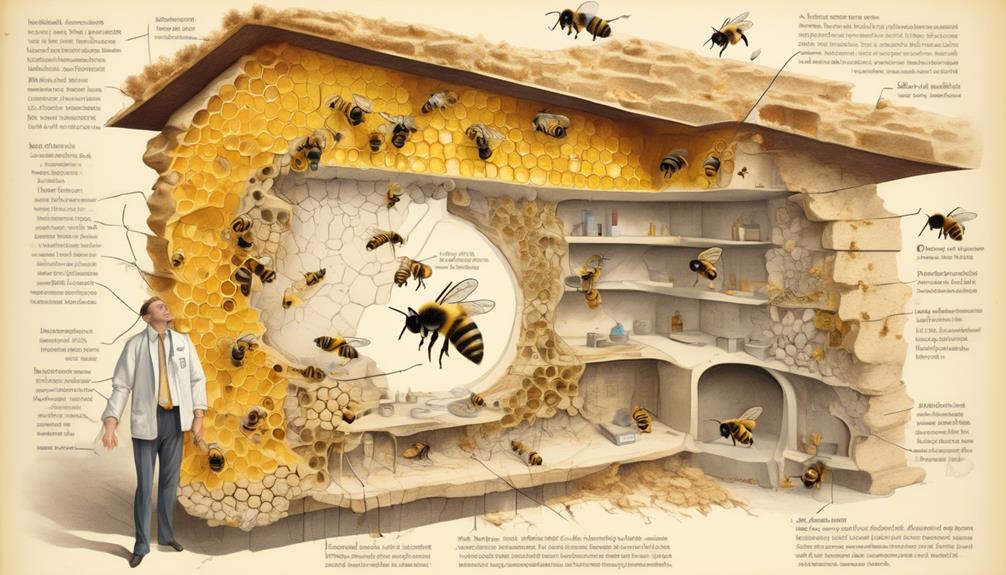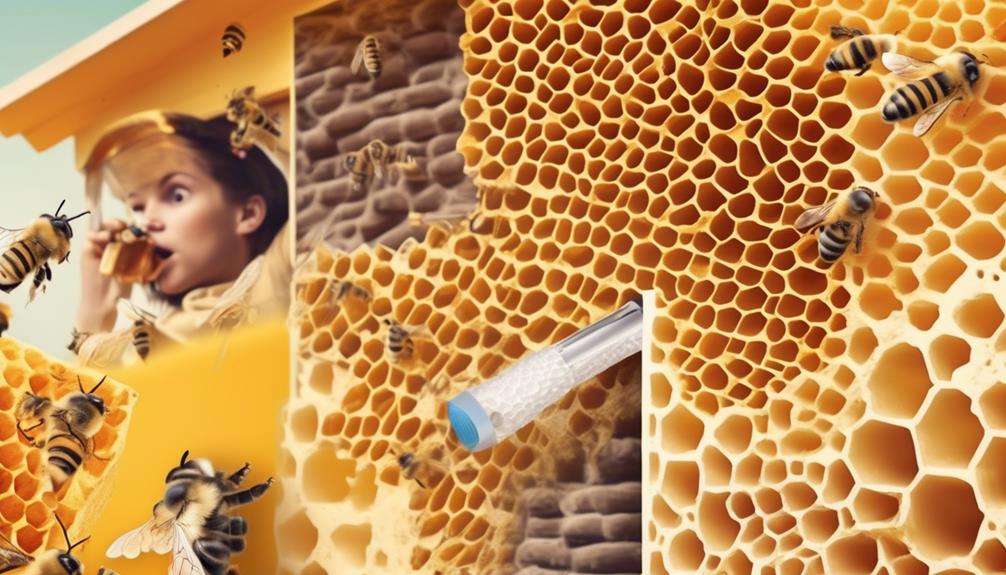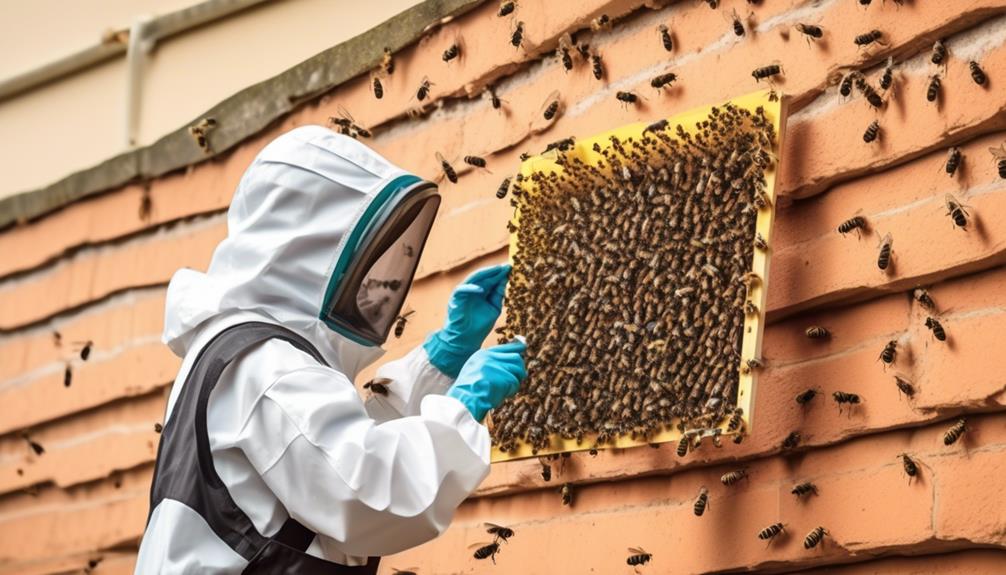Uncover the hidden buzz in your home and learn how to detect if bees have infiltrated your walls with our insightful guide.

How to Tell if Bees Are in Your Walls?
Hearing a slight buzzing, spotting unusual activity near your walls, and noticing a considerable amount of bees in your area – these are all signs that you might have bees residing in your walls. You're curious, perhaps concerned, and you're wondering what to do next.
Well, you've come to the right place for answers. We've got all the tools and tips to help you identify if these buzzing guests have taken up residence within your home. Stick with us as we navigate through this intriguing topic. The secret behind those walls may surprise you.
Key Takeaways
- Listen for a low-frequency buzzing sound during the warmest parts of the day, which is produced by bees' wings flapping at a rapid rate.
- Look for signs of unusual wall activity, such as bees entering and exiting through small openings, an increase in humidity or heat radiating from walls, and warm spots or damp patches on the walls.
- Recognize beehive structure signs, including the hexagonal shape made from beeswax, traces of wax or propolis on walls, and dark spots as entrances to the hive.
- Spot bees around your home, such as bees flying in a straight line, swarming in a buzzing mass, or increased activity near flowers or sweet substances. These may indicate a potential bee infestation in the walls.
Identifying the Buzzing Sounds

Often, the first clue you'll notice when bees have made a home in your walls is a persistent, low-frequency buzzing sound, especially during the warmest parts of the day. This sound is produced by the bees' wings flapping at an incredible speed of approximately 200 beats per second. You're not just hearing the hum of a single bee, but the collective vibration of an entire colony.
Distinct from other household pests, bees' buzzing has a rhythmic, pulsating characteristic. Unlike the erratic, high-pitched sounds of flies or the intermittent chirping of crickets, bees produce a steady, monotone hum that's often described as calming, yet disconcerting when you realize it's coming from inside your walls.
Your walls may also feel warm to the touch, another telltale sign of a bee infestation. Bees regulate their hive's temperature meticulously, often maintaining it around 95°F, which can cause the surrounding areas to heat up.
Observing Unusual Wall Activity

In addition to the distinctive buzzing, you might observe other unusual activities that suggest bees are living within your walls. Observing wall activity can be as simple as watching for bees entering and exiting through small openings. These could be cracks in the brickwork, gaps in the siding, or holes around pipes. Bees are adept at exploiting such spaces.
You may also notice an unexplained increase in humidity or heat radiating from your walls. Bees, especially honey bees, maintain a constant temperature in their hives to protect the brood and the honey. This heat can sometimes permeate through your walls. If you feel a warm spot on the wall, it could indicate a hive.
Another sign is recurring damp or dark patches on your walls, which can be a result of bee activity. When bees build nests inside walls, they can cause condensation due to the heat and moisture they produce. Over time, this can lead to damp patches or even mold growth.
Recognizing Beehive Structure Signs

While you're keeping an eye out for unusual wall activity, it's also crucial to recognize signs of the intricate structure of a beehive itself. Bees are master architects, creating complex structures with precision. Their hives are typically hexagonal in shape and are made from beeswax, a substance they secrete. If you spot these geometric designs, you're likely dealing with a beehive.
In your walls, bees may leave behind traces of wax or propolis, a resinous substance used to seal entrances and exits. You might notice a waxy, sticky residue or spots on your walls, which could be a sign of a hive. Look out for dark spots, as these could be entrances to the hive.
Additionally, pay attention to the temperature. Bees maintain their hives at a constant temperature of around 35°C (95°F), which may cause a noticeable warmth in the wall.
Also, listen for a humming sound. Bees are noisy creatures, and their constant buzzing could be a clue.
Spotting Bees Around Your Home

Have you noticed an unusual number of bees buzzing around your garden, patio, or near your windows? This could be a sign of a potential bee infestation in your walls. Here's how to spot these buzzing insects at home.
Firstly, pay close attention to the bees' behavior. If they're flying in a straight line, then they're probably returning to a hive nearby – possibly within your walls. Bees also tend to swarm when their hive becomes overcrowded, forming a buzzing, swirling mass. If you spot such a spectacle, it's a clear sign of a bee colony nearby.
Remember, bees are attracted to flowers and sweet substances. So, if you've planted many flowers or left sugary substances out, you're more likely to notice an increase in bee activity.
Given their small size, these insects may seem harmless. However, a bee infestation can pose serious risks to your home and health. Don't attempt to remove them yourself as their stings can be dangerous, particularly to those allergic. If you spot signs of a bee infestation, it's always best to call a professional pest control service.
Professional Inspection and Removal

Should you notice signs of a bee infestation, it's crucial to promptly enlist the help of a professional pest control service for an inspection and safe removal. These experts possess the necessary knowledge and equipment to accurately identify the extent of the infestation and devise a suitable eradication plan.
The initial inspection phase involves assessing the exact location and size of the hive, which can often be hidden within walls or roof spaces. This is done using infrared technology to detect heat signals generated by the bee colony, without causing any damage to your property.
Once the hive's location is confirmed, the removal process can begin. This is typically accomplished by using specifically designed vacuum devices to safely and humanely remove the bees. The hive and any honeycomb are also removed to prevent attracting other pests.
Afterward, the area is treated with special substances to deter any returning bees from reestablishing a colony. It's important to remember that bee removal isn't a do-it-yourself job. It requires professional handling due to the potential for stings and structural damage. Therefore, seeking professional help isn't only the safest but the most effective way to deal with a bee infestation.
Frequently Asked Questions
What Are the Potential Risks to My Health if Bees Are Living in My Walls?
Bees in your walls can pose health risks, especially if you're allergic to bee stings. A hive can house thousands of bees, increasing chances of an encounter. Even if you're not allergic, multiple stings can be dangerous.
Bees inside walls can attract other pests, potentially causing an infestation. Finally, honey and wax buildup can lead to structural damage and mold growth, affecting your home's air quality and your health.
Can Bees Cause Structural Damage to My Home?
Yes, bees can cause structural damage to your home. They don't eat wood like termites, but their nesting can weaken structures.
Honey bees pose a unique risk. Their honey can seep into your walls, damaging insulation and attracting pests. Plus, if a hive dies out, honey can ferment, causing a strong odor.
How Do I Prevent Bees From Entering My Walls in the First Place?
To prevent bees from entering your walls, you've got to make your home less appealing to them. Start by sealing cracks and crevices in your walls and around windows.
Don't leave sweet substances, like sugary drinks or ripe fruit, out in the open. Control flowering plants, as they're bee attractants.
If I Have a Bee Allergy, What Precautions Should I Take if I Suspect Bees in My Walls?
If you're allergic to bees, take precautions. Avoid areas where you suspect bees may be.
If you see bees entering or exiting a hole in your wall, there's likely a hive inside. Don't attempt to remove it yourself; call a pest control professional.
Always carry your EpiPen or other prescribed emergency treatment. Wear protective clothing when outside and keep windows and doors closed to prevent bees from entering your home.
Are There Legal Restrictions on Removing Bees From My Walls?
Yes, there are legal restrictions on removing bees. You can't just exterminate them; they're essential pollinators. Some species are protected, so it's illegal to harm or kill them. Always consult a professional beekeeper or pest control service. They'll identify the species and use appropriate, legal methods for removal.
If you're allergic, stay clear of the area until help arrives. Laws vary by location, so check your local regulations for specifics.
Conclusion
In conclusion, if you're hearing persistent buzzing, noticing unusual wall activity, spotting hive structures, or frequently seeing bees around your home, you may have a bee problem.
It's crucial to call in professionals for inspection and removal to avoid potential damages and stings. Remember, bees are essential for our ecosystem, so their removal should be handled humanely.
Stay alert and proactive in identifying these signs to maintain a safe, bee-free home.



